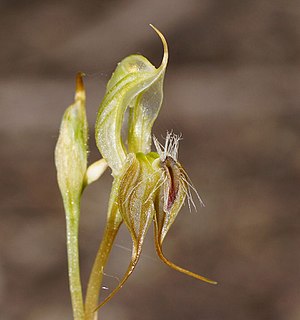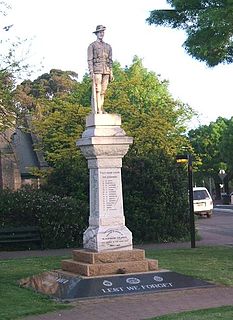
Pterostylis cheraphila, commonly known as the floodplain rustyhood is a plant in the orchid family Orchidaceae and is endemic to a small area in Victoria. It has a rosette of leaves near its base and up to seven dark brown to blackish flowers with a dark brown, insect-like labellum. It is only found in the Little Desert area.

Pterostylis cobarensis, commonly known as the inland rustyhood or Cobar rustyhood is a plant in the orchid family Orchidaceae and is endemic to Australia. It has a rosette of leaves and between two and ten hairy, green and brown flowers with translucent white "windows" and a fleshy, insect-like labellum. It grows in inland areas of eastern Australia.

Pterostylis lingua, commonly known as the large-lipped rustyhood, is a plant in the orchid family Orchidaceae and is endemic to south-eastern Australia. It has a rosette of leaves and up to ten dark reddish-brown flowers with translucent "windows" and a blackish, insect-like labellum.

Pterostylis maxima, commonly known as the large rustyhood, is a plant in the orchid family Orchidaceae and is endemic to south-eastern Australia. It has a rosette of leaves at its base and up to eight relatively large, dark brown flowers with transparent "windows" and a thin, dark insect-like labellum.

Pterostylis setifera, commonly known as the bristly rustyhood or sikh's whiskers, is a plant in the orchid family Orchidaceae and is endemic to south-eastern Australia. It has a rosette of leaves and four to ten translucent white, green and brown flowers which have an insect-like labellum with long, bristly hairs.

Pterostylis squamata, commonly known as the southern rustyhood or ruddyhood, is a plant in the orchid family Orchidaceae and is endemic to south-eastern Australia. Flowering plants have up to ten translucent green flowers with reddish-brown markings and a hairy, insect-like labellum. Non-flowering plants have a rosette of four to eight egg-shaped leaves. This species is very similar to Pterostylis rufa which has a narrower labellum and other minor differences.

Pterostylis hamata, commonly known as the southern hooked rustyhood, is a plant in the orchid family Orchidaceae and is endemic to eastern Australia. It has a rosette of leaves and between two and twelve transparent flowers with green and brown markings, a thick, brown, insect-like labellum and dished lateral sepals.

Pterostylis boormanii, commonly known as the Sikh's whiskers, baggy britches, or Boorroans green-hood is a plant in the orchid family Orchidaceae and is endemic to south-eastern Australia. It has a rosette of leaves and up to seven dark reddish-brown flowers with translucent "windows" and a thick, brown, bristly, insect-like labellum.
Pterostylis chaetophora, commonly known as the Taree rustyhood, tall rusthood or ruddy hood is a plant in the orchid family Orchidaceae and is endemic to eastern Australia. It has a rosette of leaves at its base and up to twelve reddish-brown flowers with translucent "windows" and a fleshy, reddish-brown, bristly, insect-like labellum.
Pterostylis commutata, commonly known as the midland rustyhood is a plant in the orchid family Orchidaceae and is endemic to Tasmania. It has a rosette of leaves near its base and up to five translucent white and green flowers with a hairy, insect-like labellum. It is only found in a small area near Tunbridge and Ross.
Pterostylis excelsa, commonly known as the tall rustyhood, or dry land green-hood is a plant in the orchid family Orchidaceae and is endemic to South Australia. It has a rosette of leaves and when flowering, up to twenty green or brown flowers which lean forward and have a thick, fleshy, partly hairy, insect-like labellum.
Pterostylis ferruginea, commonly known as the Bangham rustyhood, is a plant in the orchid family Orchidaceae and is endemic to the border area between South Australia and Victoria. It has a rosette of leaves and when flowering, up to ten upright, dark green and translucent white flowers which have an insect-like labellum.
Pterostylis gibbosa, commonly known as the Illawarra rustyhood, or Illawarra greenhood, is a plant in the orchid family Orchidaceae and is endemic to New South Wales. It has a rosette of leaves at its base and up to nine bright green flowers with translucent "windows", relatively wide lateral sepals with short-pointed tips and a dark, fleshy, insect-like labellum.
Pterostylis mitchellii, commonly known as Mitchell's rustyhood, is a plant in the orchid family Orchidaceae and is endemic to eastern Australia. Both flowering and non-flowering plants have a rosette of leaves and flowering plants have up to fifteen flowers which have wide flanges on the petals and an insect-like labellum with a white "head".
Pterostylis ovata, commonly known as the Gawler Range rustyhood, is a plant in the orchid family Orchidaceae and is endemic to South Australia. Both flowering and non-flowering plants have a rosette of leaves and flowering plants have up to six flowers which have transparent flanges on the petals and a striped, insect-like labellum.

Pterostylis pusilla, commonly known as the tiny rustyhood is a plant in the orchid family Orchidaceae and is endemic to southern Australia. It has a rosette of leaves and up to nine relatively small green and reddish-brown flowers with translucent white "windows" and a dark brown, insect-like labellum.
Pterostylis saxicola, commonly known as the Sydney plains rustyhood, or Sydney plains greenhood, is a plant in the orchid family Orchidaceae and is endemic to New South Wales. It has a rosette of leaves at its base and up to ten reddish-brown flowers with translucent "windows", relatively wide lateral sepals with short-pointed tips and a dark brown, fleshy, insect-like labellum.
Pterostylis xerophila, commonly known as the desert rustyhood, is a plant in the orchid family Orchidaceae and is endemic to South Australia. Both flowering and non-flowering plants have a relatively large rosette of leaves. Flowering plants also have up to eight translucent white, green and reddish-brown flowers with an insect-like labellum.





















